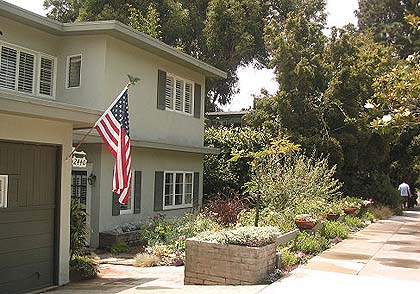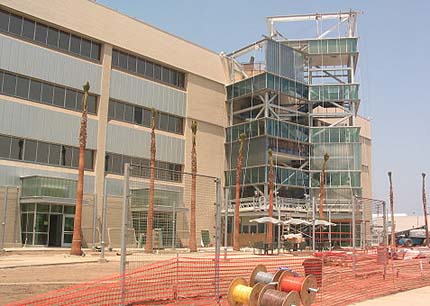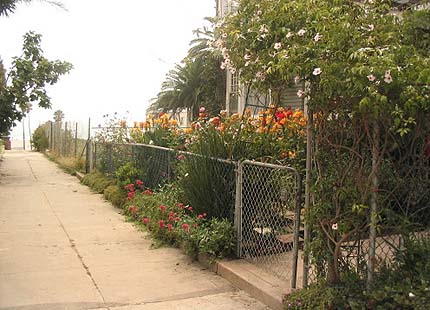| The LookOut columns |

|
What I Say | About
Frank Gruber Email Frank |
||||||||||
|
Glengarry Glen Santa Monica? "If we do walk down the street (and) we find ourselves looking into our neighbor's yard, (and) we catch his or her eyes, what we do is lower our head, because what we've done is violate their privacy." -- Playwright David Mamet speaking to the Santa Monica City Council on the issue of hedges and fences, July 12, 2005 By Frank Gruber Thrills are few in my humdrum life, but I can feel a little illicit as I walk the streets of Santa Monica. A quick and furtive glance into my neighbor's yard; a glimpse of the flowers; a look at the car in the driveway. Uh-oh -- a neighbor. He or she looks up and I catch his or her eyes. The tension is palpable; my heart beats; nevertheless, I savor the excitement as I violate his or her privacy. Can I bear it? Will I look down, caught, in shame, humiliated? Or, shall I flaunt my aggression, taking advantage of the absence of a hedge or fence (higher than 42 inches)? I can feel the hairs on the back of my neck rise, but then, then . . . my neighbor nods. I nod back. He or she smiles. I do, too. I give a little wave as a walk on by -- looking for my next victim.
David Mamet said he's lived in Santa Monica about three years. Maybe his experiences have been noir-ish, but I suspect he's missing the point of living here. I mean I hope Mr. Mamet doesn't stop writing plays with characters full of rage and on the edge, but maybe -- just maybe -- he ought to stretch his legs and sample the local ethos of neighborliness. Look, I'm not naïve. I know this whole friendliness thing is a façade -- communitarian propapganda and bourgeois lies. I know that underneath the nods and the smiles and the waves, we loathe our neighbors and seethe with envy and frustration. I respect the courage of artists like Mr. Mamet who aren't afraid to expose the harsh truths of our deepest fears. But if the civility that typifies neighborhoods in Santa Monica is a mere delusion, it's a pleasant one, and I hope we keep it. * * * I've written plenty about hedges and fences and basically planning staff and the City Council did a conscientious job revising the law ("Council Makes Room for Taller Hedges and Fences," July 13, 2005). I especially commend Mayor Pam O'Connor and Council members Richard Bloom and Ken Genser for not allowing everyone to forget those communitarian traditions that are a part of Santa Monica. I don't have much else to add, except that readers who followed last year's saga of the Stephanie Barbanell/Jerry Bass hedge and fence over on Seaview Terrace might want to know that, notwithstanding the Planning Commission's vote to have the Barbanell/Bass's open up their front yard, it looks like their six-foot fence as well as their fourteen-foot hedge are here to stay. Ever since the Council voted to "grandparent" currently unlawful hedges the hedge has looked golden, but now the fence appears safe, too, thanks to a last minute motion by Kevin McKeown to grandparent over-high fences and walls as well as hedges. The motion passed with no discussion with the votes of council members McKeown, Herb Katz, Robert Holbrook and Bobby Shriver.
* * * If you want to see a big wall, go over to the neighborhoods in Mar Vista near Santa Monica College's new Bundy campus. Neighbors there have had the College construct a ten-foot wall on its southern and western flanks to separate them from a campus where the College will be training nurses and nursery school teachers and offering lifelong learning courses in art and other subjects.
Meanwhile, at the behest of Sunset Park neighbors long at odds with the college, and Ken Genser and Richard Bloom, their champions on the City Council, the City has been harassing the College over numerous issues by threatening to cut off the traditional (and safe) access to the new campus from Airport Avenue. ("College Board Scales Down Bundy Campus Plan," July 7, 2005) The College's administration is putting up a stiff upper lip, and going along as best they can, but the Bundy campus situation is a sad commentary on how our obsession with traffic can pervert our values. Think about what is going on. Our local economy, once based on manufacturing, specifically aerospace, is changing, and what had been for decades quite a large manufacturing and research center, most recently owned and operated by BAE, has closed. The future for our region is in new fields, like information and healthcare, not the manufacturing sector, and we need a more highly trained workforce. Meanwhile, the number of people needing more education, training, and retraining is exploding -- along with grown-ups who want to keep learning. So the logical thing happened -- BAE sold out to Santa Monica College. The site, surrounded by neighborhoods and across Airport Avenue from a future park, will now have a campus instead of a factory.
Sounds like a good deal to me. A campus open to the community instead of a factory. But that's not how it works these days. It's all about traffic, even though replacing the factory with the college will have only a trivial impact on traffic. Council members and neighbors who have fought the College on traffic in Sunset Park have trumped up the issue about access to the site to get "leverage," when the real issues for the City should be how to enhance the connections between the new campus and the city (in particular by bus) and the connection between the new campus and the new park the City is building on the other side of Airport Avenue (which will also need bus service). Meanwhile, Sunset Park neighbors have squared off against Mar Vista neighbors as to where cars should exit -- on Bundy, or to 23rd Street by way of Airport Avenue -- when anyone who studies traffic will tell you that the best solution not only for motorists (particularly Santa Monicans who might come and go in either direction) but also for residents is to disperse traffic in as many directions as possible. What the Sunset Park and Mar Vista neighbors should be talking to the City about is creating a new north-south bus route, using quiet new buses, along 23rd Street, to give commuters an alternative to driving. (In the disclosure of conflicts department, please note that my son is taking courses at the College this summer, and his experiences have enhanced the high opinion of the College I already had.) * * * I agree with Council member Ken Genser that I'm not an expert in historic preservation. ("Council Overturns Landmark Status, Debates Commision's Powers," July 14, 2005) But then, the City Council is the ultimate arbiter of the standards for landmarks, and the council members aren't necessarily experts either. (Mayor Pam O'Connor happens to be one, but that's a fluke.) Landmarking standards are ultimately political. We saw that a couple years ago when the preservation community opposed the initiative to require owner approval before a property could be landmarked. The argument against the initiative (which was worth opposing in any case) was not a positive one based on the value of preserving our heritage, but a negative one based on fear of "big developers" who would destroy neighborhoods. You reap what you sow. Planning staff supported the appeal on the 19th Street bungalow because they believed the Landmarks Commission had lowered the standard contemplated by the City Council when it passed the ordinance. As I wrote last year, when the commissioners landmarked the house, they spent more time wallowing in nostalgia for a lost era of single-family homes than they did coming up with real reasons to value that particular house. ("WHAT I SAY: Landmark Tale of Tow Grages,: September 20, 2004) At the City Council hearing there was a lot of talk about how many similar bungalows exist in Santa Monica. The point is not the number, however, it's the quality. If we had a hundred Greene & Greene masterpieces, I would say landmark them all. But 921 19th Street is no masterpiece. The true historic significance of 19th Street is just what the Landmarks Commission didn't like, the fact that the neighborhood made the transition to a denser urban fabric. Because of more rigid zoning today, that transition is now impossible in most places. But about 70 percent of Santa Monicans live in apartments, and that's who we are. Council member Kevin McKeown, who rents an apartment in the same neighborhood as the house, bemoaned the politicizing of the landmarking decisions. This was ironic for a couple reasons. First, if the logic of the Landmarks Commission had been followed 50 years ago, Council member McKeown wouldn't have an apartment in the neighborhood because there wouldn't be any. Second, if he didn't have an apartment, Council member McKeown wouldn't be on the City Council, and he wouldn't have made the motion later in the evening that saved the Barbanell/Bass Fence on Seaview Terrace. But the historic nature of Seaview Terrace, as planned by its developer, was to be a walk street within a 30-foot "wide-open" view corridor toward the beach. The Barbanell/Bass fence obstructs that history.
* * * Congratulations to Hank Koning on his appointment last week to the Planning Commission. Mr. Koning is truly a "world class" appointment. Congratulations to the Council for appointing him, too, but it's important to note the exceptional quality of the Santa Monicans who applied for the position. Any of Mr. Koning, Maria Loya, Dennis Woods, or Jim Ries would have been an excellent addition to the commission, and here's hoping they keep their hats in the ring for future openings. | ||||||||||||
| |
The
views expressed in this column are those of Frank Gruber and do not necessarily reflect the opinions of The Lookout. |
Copyright 1999-2008 surfsantamonica.com. All Rights Reserved. |




